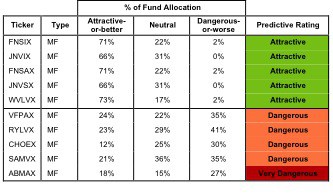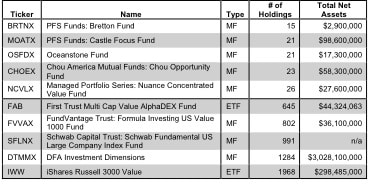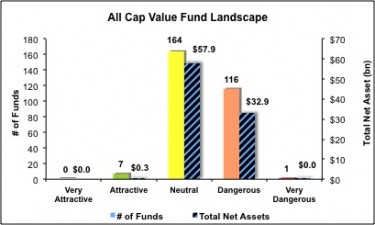The all-cap value style ranks sixth out of the twelve fund styles as detailed in my style roadmap. It gets my Neutral rating, which is based on aggregation of fund ratings of 288 all-cap value funds. Reports on the Best & Worst funds in every style and sector are here.
Per Figure 1, only 7 of the 288 funds (less than %1 of the total net assets) are worthy of investment. Looking closer, 1749 stocks (over 68% of the market cap) held by all-cap growth funds get a Neutral-or-worse rating. The takeaway is: fund managers allocate too much capital to low-quality stocks.
Investors seeking exposure to all-cap value stocks should buy a basket of Attractive-or-better rated stocks and avoid paying underserved fund fees.
As detailed in “Cheap Funds Dupe Investors”, the fund industry offers many cheap funds but very few funds with high-quality stocks, or with what I call good portfolio management.
Figure 1: All-cap Value Style Landscape For Funds & Stocks
The 288 all-cap value are very different. Per Figure 2, the number of holding varies widely (from 15 to 1968), which creates drastically different investment implications and ratings. Review my full list of ratings along with free reports on all 288 all-cap value funds.
How do investors pick the fund that will most likely deliver the best future returns?
Figure 2: Funds with Most & Least Holdings – Top 5
To identify the best funds within a given category, investors need a predictive rating based on analysis of the underlying quality of stocks in each fund. See Figure 3.
My predictive fund ratings are based on aggregating (1) my stock ratings on each of the fund’s holdings and (2) all of the fund’s expenses. Investors should not rely on backward-looking research.
Figure 3 shows the five best and worst-rated funds for the style. The best funds allocate more value to Attractive-or-better-rated stocks than the worst funds and vice versa. The worst funds have poor holdings quality and charge high total annual costs.
Figure 3: Funds with the Best & Worst Ratings – Top 5
 * MF designates Mutual Funds and ETF designates Exchange-Traded Funds
* MF designates Mutual Funds and ETF designates Exchange-Traded Funds
Sources: New Constructs, LLC and company filings
My top-rated all-cap value fund is FundVantage Trust: Formula Investing US Value Select Fund [s: FNSIX], which gets my Attractive rating. One of its largest holdings and part of the 71% allocated to Attractive-or-better stocks is Forest Laboratories [s: FRX], which gets my Very Attractive rating. I am bullish on the health care sector and FRX is one of the best stocks in that sector. The company’s 2011 ROIC is over 50% and has stayed above 30% for the past 10 years. Over the same 10-year period, the company has managed to increase economic earnings from $203.9 million to $954 million, a 467% increase. Given the weak state of FRX’s drug portfolio and impending patent expirations, it is difficult to expect the company to continue its meteoric value creation.
However, the market’s expectation for a permanent 55% decline in after-tax cash flows (NOPAT) is too pessimistic. My analysis, based on the stock’s current valuation at about $31.66/share, suggests that any drop in profits less than 55% will drive the stock up.
My worst-rated all-cap value fund is American Beacon Mid-Cap Value Fund [s: ABMAX], which gets my Very Dangerous rating. One of its largest holdings and part of the 27% allocated to Dangerous-or-worse stocks is Masco Corp [s: MAS], which gets my Dangerous rating. I am generally bearish on the materials sector and this stock is one of the worst in the sector. The company has not earned an ROIC greater than its cost of capital (WACC) for the past 13 years, which is as far back as my model goes. Over the last 2 years, its ROIC is under 2%. Part of what drives down ROIC in my model is the $3.1 billion of write-offs the company has made over the past 10 years. Management has written off about 45 cents for every dollar of shareholder equity. This company is a value destroyer. Investors deserve better stewardship of their capital.
Investors also owe it to themselves to buy cheaper stocks. MAS’ valuation (~$12.82/share) implies the company will grow NOPAT at 20% compounded annually for over 13 years. I doubt even the best tech company over the next 13 years will grow that fast.
Investors need to tread carefully when considering all-cap value funds, as 97% are not worth buying. Only 7 of the 288 funds allocate enough value to Attractive-or-better-rated stocks to earn an Attractive rating. Figure 4 shows the rating landscape of all ETFs and mutual funds in the all-cap value style.
Our style roadmap report ranks all styles and highlights those that offer the best investments.
Figure 4: Separating the Best Funds From the Worst Funds
Figure 5 lists our Predictive Fund Rating for the 5 largest and most popular all-cap value funds.
Figure 5: Five Largest All-cap Value Funds
 * MF designates Mutual Funds and ETF designates Exchange-Traded Funds
* MF designates Mutual Funds and ETF designates Exchange-Traded Funds
* Analysis uses the top-ranked class for each fund
Sources: New Constructs, LLC and company filings
Review my full list of ratings and rankings along with free reports on all 288 all-cap value funds.
Disclosure: I receive no compensation to write about any specific stock, sector or theme.


